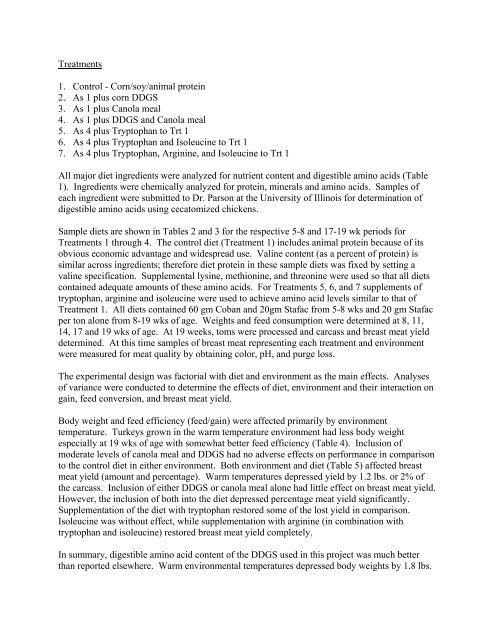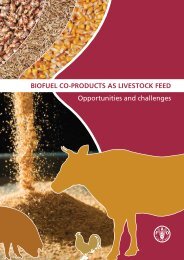Distillers Grains Feeding Recommendations. - Distillers Grains By ...
Distillers Grains Feeding Recommendations. - Distillers Grains By ...
Distillers Grains Feeding Recommendations. - Distillers Grains By ...
Create successful ePaper yourself
Turn your PDF publications into a flip-book with our unique Google optimized e-Paper software.
Treatments1. Control - Corn/soy/animal protein2. As 1 plus corn DDGS3. As 1 plus Canola meal4. As 1 plus DDGS and Canola meal5. As 4 plus Tryptophan to Trt 16. As 4 plus Tryptophan and Isoleucine to Trt 17. As 4 plus Tryptophan, Arginine, and Isoleucine to Trt 1All major diet ingredients were analyzed for nutrient content and digestible amino acids (Table1). Ingredients were chemically analyzed for protein, minerals and amino acids. Samples ofeach ingredient were submitted to Dr. Parson at the University of Illinois for determination ofdigestible amino acids using cecatomized chickens.Sample diets are shown in Tables 2 and 3 for the respective 5-8 and 17-19 wk periods forTreatments 1 through 4. The control diet (Treatment 1) includes animal protein because of itsobvious economic advantage and widespread use. Valine content (as a percent of protein) issimilar across ingredients; therefore diet protein in these sample diets was fixed by setting avaline specification. Supplemental lysine, methionine, and threonine were used so that all dietscontained adequate amounts of these amino acids. For Treatments 5, 6, and 7 supplements oftryptophan, arginine and isoleucine were used to achieve amino acid levels similar to that ofTreatment 1. All diets contained 60 gm Coban and 20gm Stafac from 5-8 wks and 20 gm Stafacper ton alone from 8-19 wks of age. Weights and feed consumption were determined at 8, 11,14, 17 and 19 wks of age. At 19 weeks, toms were processed and carcass and breast meat yielddetermined. At this time samples of breast meat representing each treatment and environmentwere measured for meat quality by obtaining color, pH, and purge loss.The experimental design was factorial with diet and environment as the main effects. Analysesof variance were conducted to determine the effects of diet, environment and their interaction ongain, feed conversion, and breast meat yield.Body weight and feed efficiency (feed/gain) were affected primarily by environmenttemperature. Turkeys grown in the warm temperature environment had less body weightespecially at 19 wks of age with somewhat better feed efficiency (Table 4). Inclusion ofmoderate levels of canola meal and DDGS had no adverse effects on performance in comparisonto the control diet in either environment. Both environment and diet (Table 5) affected breastmeat yield (amount and percentage). Warm temperatures depressed yield by 1.2 lbs. or 2% ofthe carcass. Inclusion of either DDGS or canola meal alone had little effect on breast meat yield.However, the inclusion of both into the diet depressed percentage meat yield significantly.Supplementation of the diet with tryptophan restored some of the lost yield in comparison.Isoleucine was without effect, while supplementation with arginine (in combination withtryptophan and isoleucine) restored breast meat yield completely.In summary, digestible amino acid content of the DDGS used in this project was much betterthan reported elsewhere. Warm environmental temperatures depressed body weights by 1.8 lbs.
















